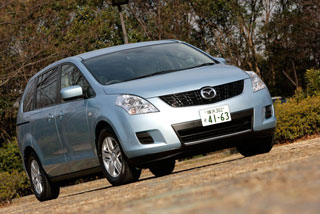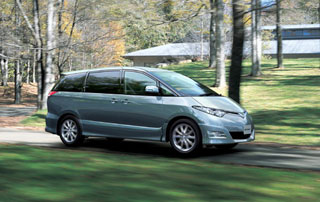Test drive Mazda MPV 1999 - 2006
Test drive by the Mazda MPV car of the new modification - "23t"
 The machine competes with 3-liter-class minivans equipped with 6-cylinder V-shaped engines.
The machine competes with 3-liter-class minivans equipped with 6-cylinder V-shaped engines. Well, finally, the time has come when you can drive the new Mazda MPV 23T car, in which, as you know, the combination of the minivan minivan is used for the first time, and make a trial trip on it! I think that true lovers and experts in cars will understand the reason for my excitement correctly. For everyone else, I will make a small explanation.
So, the official information that Mazda has begun to produce a fully updated MPV car was on February on February on February of this year. At the same time, it was stated that the new machine would be produced with the already known engine of the MZR series with a working volume of 2.3 liters. True, he, in turn, can go with a simple intake system, or be equipped with a turbocharger. And yet, regardless of engine modification, the new MPV model will have a front wheel drive or a 4WD all -wheel drive. However, one reservation was made: according to the production plan for sale, different models will not be done immediately, but with a small gap in time. And the implementation with the most massive, as planned, will begin modifications, which is equipped with a simple (not turbo) engine and has a front wheel drive. So it happened. And only on March 20, that is, after a month and a half, another type of new machine was launched on the market - the MPV 23T model, also with front -wheel drive. Moreover, then, in February, when an official presentation of an updated model range for representatives of the press was carried out, this model could not be tested. By the way, with regard to the all -wheel drive version of the machine, the beginning of its implementation is scheduled for April 15, so when this report is published, it is likely that all modifications included in the updated MPV lineup will already run along the roads.
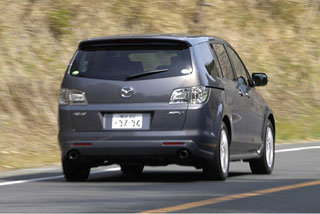 Now directly about the MPV 23T model. To equip it, a 2.3 -liter serial motor was taken, which, however, was undergoed by a direct injection system developed at the Mazda company and designated by the DISI letter, as well as a Turbo Charger turbocharger. More precisely, this is the same development that is used in the Mazda Atenza model, and it is also planned to be installed on the Mazda Speed \u200b\u200bAcceler car, which is about to appear on sale. But what is interesting: judging only by the engine, the MPV 23T car must have extreme rejection. But I was convinced that this is not so and that it is essentially very balanced and differed, so to speak, a flexible character.
Now directly about the MPV 23T model. To equip it, a 2.3 -liter serial motor was taken, which, however, was undergoed by a direct injection system developed at the Mazda company and designated by the DISI letter, as well as a Turbo Charger turbocharger. More precisely, this is the same development that is used in the Mazda Atenza model, and it is also planned to be installed on the Mazda Speed \u200b\u200bAcceler car, which is about to appear on sale. But what is interesting: judging only by the engine, the MPV 23T car must have extreme rejection. But I was convinced that this is not so and that it is essentially very balanced and differed, so to speak, a flexible character. If we draw an analogy and try to find something similar among cars of other manufacturers, then I would compare the new MPV 23T car with a modern minivan of 3 3.5 liter class equipped with a V-shaped engine with 6 cylinders. So there is no doubt that both in terms of equipment and in convenience in control, this model is a kind of flagship, or better to say, the standard of Mazda brand machines, it seemed so perfect to me. It is possible that to characterize this car can be used as a keyword definition of Sporty, that is, with an active character. But I think that this is a very conditional definition, which does not convey the true state of affairs, but serves only to highlight this model among other representatives of the MPV model range, or, wider, among other machines now manufactured under the Mazda brand.
Why is a four -cylinder engine selected for the MPV turbo machine?
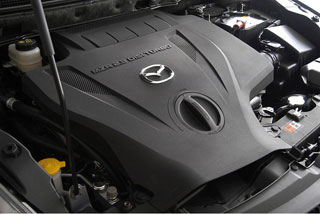 The MPV car has a new one, now the third generation has one feature: it was not planned to sell it in the North America market unlike their predecessors. And, therefore, when it was developed, the designers could forget about the requirements that Americans present to a car like minivan. And these requirements are as follows: the minivan should have a 6-cylinder V-shaped motor and a very roomy trunk. So the six -cylinder motor, which was equipped with the previous model, was replaced by a 2.3 -liter turbo engine. The luggage compartment became slightly smaller in volume, but we can agree with this, given that the height of the machine also decreased, and the plus to this was decided to install a special, easily folding design in the third row.
The MPV car has a new one, now the third generation has one feature: it was not planned to sell it in the North America market unlike their predecessors. And, therefore, when it was developed, the designers could forget about the requirements that Americans present to a car like minivan. And these requirements are as follows: the minivan should have a 6-cylinder V-shaped motor and a very roomy trunk. So the six -cylinder motor, which was equipped with the previous model, was replaced by a 2.3 -liter turbo engine. The luggage compartment became slightly smaller in volume, but we can agree with this, given that the height of the machine also decreased, and the plus to this was decided to install a special, easily folding design in the third row. It should be noted along the way that from the very beginning a similar sports minivan’s sports minivan was developed in the calculation that it would be on it exactly a 4-cylinder engine. This is how it was supposed to achieve the most underestimated center of gravity. In contrast to this, a new MPV car can be said to be universal, since in its motor compartment there is enough space not only for a 4 cylinder, but also a 6-cylinder engine. Thus, the reason for the choice of engine with fewer cylinders for the Japanese version of the machine is in no way related to the features of its layout. And with what then? Here they played a role in a consideration of an economic nature: since a motor can be put on a minivan that has already been developed under another model, which means that the cost of this minivan will still be lower. But, besides this, the developers faced another task: how to make an increase in power did not affect the environmental safety of the machine. In fact, in order to sharply increase the engine power, there is nothing easier than to equip it with a forced intake system of the Turbo Charger type. But recently, numerous attempts have been made in addition to solving the problem differently, due to a more thorough adjustment of the intake system, for example, by installing a low -pressure turbocharger, which is often used in European machines. And if the necessary power reserve is obtained with a relatively small fuel consumption (read, with a minimum number of cylinders), then, you see, internal losses occurring due to friction, in terms of the unit of developed power, are also reduced.
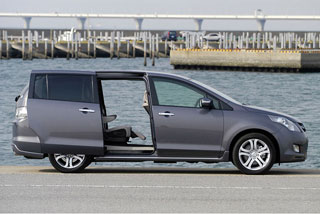 The fact that on the new MPV 23T car is the engine developed for the Speed \u200b\u200bATENZA model does not mean that the turbocharger itself has also been transferred here without changes. Of course, it was possible to ignore the difference in the weight of these two cars (the minivan body, of course, is heavier), but what would come of it!? At least, the authors of the MPV project did not take risks and made a number of changes to the designer design. The diameter of the canal was reduced, through which the spent gases are directed to the rotation of the turbine, which led to the fact that the effect of its operation becomes especially noticeable at low and medium speed of the machine. In a word, the MZR series turbine, designed specifically for minivan, was made with emphasis not at high, but at the average speed, and its work proceeds unnoticed for the driver. In general, if the driver driving this minivan does not report that the engine of the machine has a volume of 2.3 liters and a turbocharger, then he may not understand anything and believe that he has an atmospheric motor with a large working volume under the hood. I would venture to assume that, in terms of the degree of simulation of the simple engine, the turbo power unit installed on the MPV 23T car even exceeds engines equipped with low -pressure turbines used in the latest Volvo or Saab models. But the matter, apparently, is not only in the engine itself, but also in a successful torque of a 6-speed automatic transmission of the AISHIN brand. By the way, the box of the same brand is on the last Mazda Roadster model, though it is located there not across, but along the body.
The fact that on the new MPV 23T car is the engine developed for the Speed \u200b\u200bATENZA model does not mean that the turbocharger itself has also been transferred here without changes. Of course, it was possible to ignore the difference in the weight of these two cars (the minivan body, of course, is heavier), but what would come of it!? At least, the authors of the MPV project did not take risks and made a number of changes to the designer design. The diameter of the canal was reduced, through which the spent gases are directed to the rotation of the turbine, which led to the fact that the effect of its operation becomes especially noticeable at low and medium speed of the machine. In a word, the MZR series turbine, designed specifically for minivan, was made with emphasis not at high, but at the average speed, and its work proceeds unnoticed for the driver. In general, if the driver driving this minivan does not report that the engine of the machine has a volume of 2.3 liters and a turbocharger, then he may not understand anything and believe that he has an atmospheric motor with a large working volume under the hood. I would venture to assume that, in terms of the degree of simulation of the simple engine, the turbo power unit installed on the MPV 23T car even exceeds engines equipped with low -pressure turbines used in the latest Volvo or Saab models. But the matter, apparently, is not only in the engine itself, but also in a successful torque of a 6-speed automatic transmission of the AISHIN brand. By the way, the box of the same brand is on the last Mazda Roadster model, though it is located there not across, but along the body. In fact, Mazda also has its own automatic gearboxes, which are designed for cross-location engines. Take at least a 4-speed box, which has a rather long story, and is now successfully working on the anticipated modification of the MPV model range (this refers to the model equipped with a simple engine). Or, say, a 5-speed transmission that is used in ATENZA lineup machines. But neither one nor the other box is designed for such a powerful torque that differs the MZR Turbo series engine. Therefore, as the representative of the MPV 23T developers group told me, they already had to, reluctantly, stopped his choice at the transmission made by AISHIN during the work. But personally it seemed to me that in the end everything turned out, perfectly!
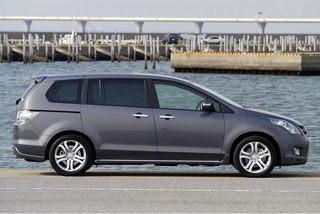 The suspension should be made such as on a car with a simple engine.
The suspension should be made such as on a car with a simple engine. In the beginning, I already noted that the main distinguishing features of the new MPV 23T machine can be called its similarity in the running characteristics with the Speed \u200b\u200bAtenza model. In particular, the speed characteristics of the MZR Turbo engine (245 horsepower, and torque 35.7 kg/m!) Inspire respect. As a third key moment, you can specify tires with profile 55, which are combined on this machine with super-large 18-inch wheels. All these advantages, however, leave an open one question: what about this model with comfort? According to the results of the test trip, I can say that in this regard, too, everything is at a high level. For example, when overcoming even rather gross joints of the road surface, blows were practically not felt. What is the reason for? Firstly, a high level of body rigidity, and secondly, probably a decrease in the minimum of friction in the details of the suspension design. If we take and objectively compare the level of the comfort of the rear seats passengers in the new MPV 23T car and in a typical high-class minivan taken from another manufacturer, which should differ in a 6-cylinder V-shaped engine, I assure you, they will not have any special in the MPV salon reasons for complaints or manifestation of discontent.
However, this is what. The version of the MPV machine with a simple engine that is equipped with 16 inches wheels, according to many, is an example of a very successful combination of two key moments of any comfort and controllability machine. Moreover, the main role in this balance of interests belongs to a skillfully configured suspension, the adjustment of which is different than the magnificent, and you cannot call it. I once again convinced of this, since the program of test races was compiled in such a way that it was possible to test both the first and the second (that is, MPV 23T) model. Comparison showed that a car suspension with a turbo engine requires further refinement. Yes, indeed, when driving along a non -even road with numerous joints, the car skillfully compensates for the shortcomings of the road surface, this is so. At the same time, I got the impression that, carried away by the problem of softening the joints on the road, the designers missed another moment: how successfully the suspension extinguishes fluctuations and how much this ability is combined with the characteristics of the wheels, in particular, with the force of adhesion of tires with the road. For example, when the car moves at high speed, and irregularities are found in the way, they are overcoming quite softly. But after each such uneven body of the car, being, as it were, in a raised position, for some time it cannot calm down. And yet, when turning the steering wheel, the front of the car goes as the driver needs. However, the roll characteristic of such a moment is, firstly, quite large, and secondly, comes with some late. When the car is in the middle of the turn, the enlarged roll is perceived as a thing quite natural. It is only important that the driver does not have the feeling that the wheels were already running forward, and the body is moving in inertia in the same direction. Then the machine is no longer perceived, as a single, monolithic structure.
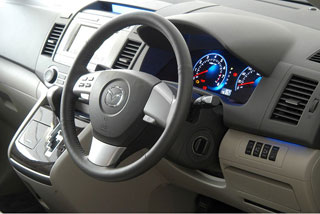 You should make a reservation: if they personally asked me whether or not to tighten the suspension even more, then I probably said no. The fact is that, as already mentioned, the MPV car body has sufficient rigidity, and therefore, if you get used to how the car behaves on an uneven road surface, in the future it will no longer cause a sense of discomfort. It is only necessary to consider that the suspension has some features that do not allow it to immediately fulfill the driver’s requirements in full. Therefore, if the driver of the road is peace and the convenience of people close to him, who are peacefully asleep in the rear seats, then when driving with high speed, the car should be entered more carefully.
You should make a reservation: if they personally asked me whether or not to tighten the suspension even more, then I probably said no. The fact is that, as already mentioned, the MPV car body has sufficient rigidity, and therefore, if you get used to how the car behaves on an uneven road surface, in the future it will no longer cause a sense of discomfort. It is only necessary to consider that the suspension has some features that do not allow it to immediately fulfill the driver’s requirements in full. Therefore, if the driver of the road is peace and the convenience of people close to him, who are peacefully asleep in the rear seats, then when driving with high speed, the car should be entered more carefully. At the same time, I want to emphasize: according to this indicator as the speed of passing the winding sections of the road, the MPV 23T car is estimated quite highly. Prior to this, such fighting qualities on the turns of Honda Odyssey, Toyota Estima and a relative of the MPV car - Mazda Premacy, were distinguished. After the MPV 23T modification appears, we can safely say that the triumph of minivans that has prevailed before that is distinguished by special controllability, is violated by another worthy competitor. So, both in running qualities and in terms of comfort, the MPV 23T car is more than at a high level, if you evaluate all models of the MPV model range, produced in the past few years. True, those of the drivers who still believe that it is more pleasant to drive a simple engine with a simple engine, probably would like to have a MPV turbo car, since it exists, overshadow all other minivans competitors, at least with their speed characteristics.
It is possible that I will show someone too picky. Well, this often happens when it occurs what is called in psychology by inflationary expectation. But if you look at everything inseparable, what can you see? The MPV 23T car is characterized by powerful thrust and reliable brakes, this, in turn, allows it, as they say, to play the winding sections of the road. Plus, a spacious, convenient salon. Thus, the consumer value of the new model can be estimated as very high. At the same time, you can purchase this car for 2 million 800 thousand yen. I want to remind you that the price of the Toyota Estima minivan similar in the class of any configuration exceeds 3 million. And even if this machine is equipped with a 6-cylinder V-shaped engine, is it worth it to overpay?
Technical characteristics of the Mazda MPV 23T SPEC machine:
Length 4870 mm x width 1850 mm x height 1685 mm.
Wheel base: 2950 mm.
Machine weight: 1800 kg.
Drive: on the front wheels
Engine: 2.3 - -lit, 4 -cylinder with an in -line location of the cylinders and two distribution shafts, turbo; Developed power 245 hp. at 5000 rpm, the largest torque is 35.7 kg/m at 2500 rpm.
Transmission: 6-speed automatic gearbox
Machine price: 2 million 800 thousand yen
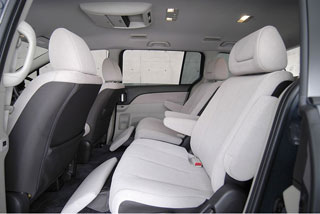
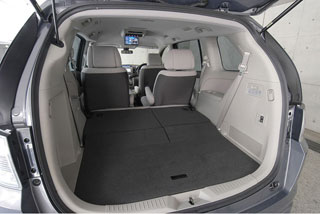
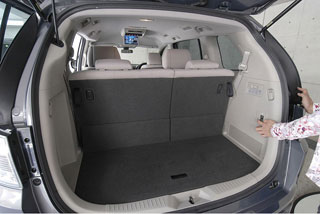
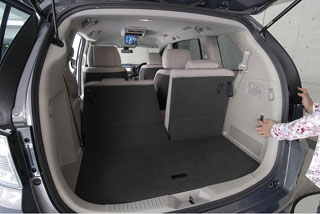
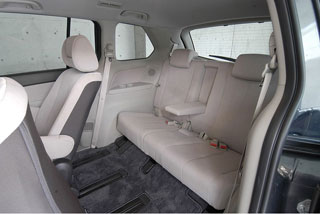
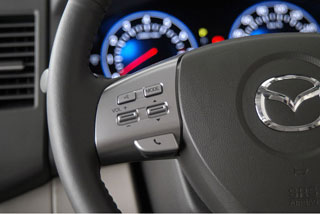
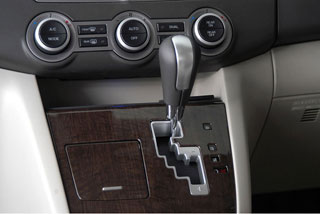
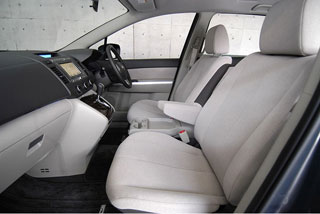
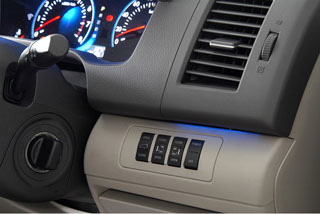
Source: CarView.co.jp










